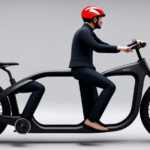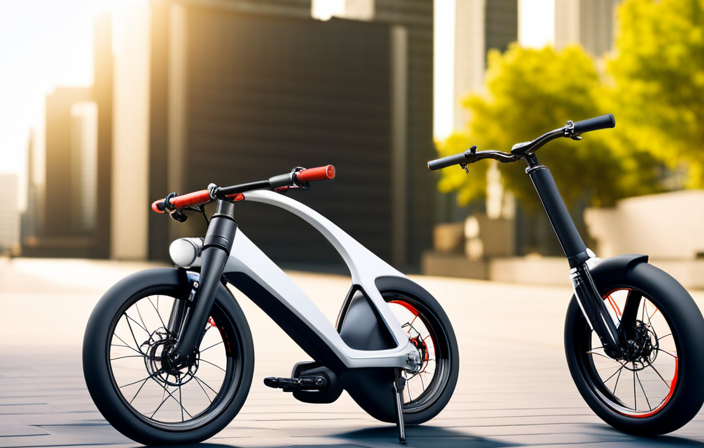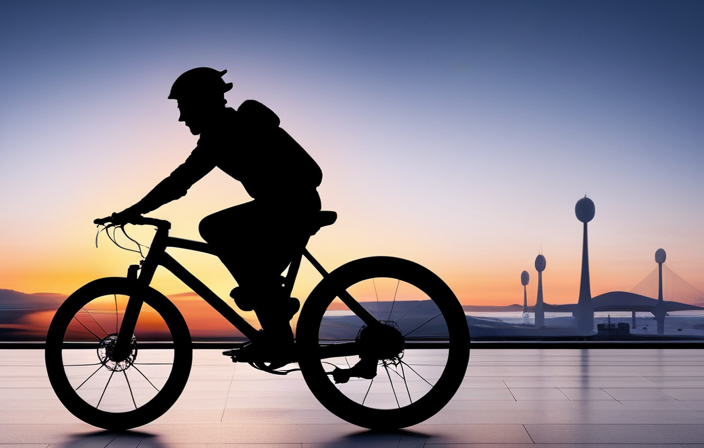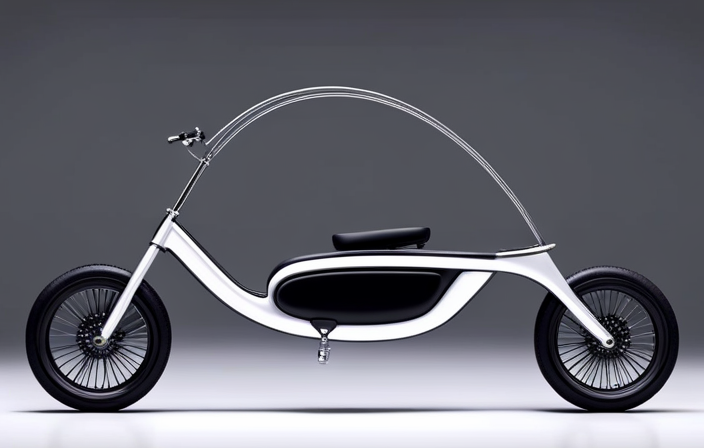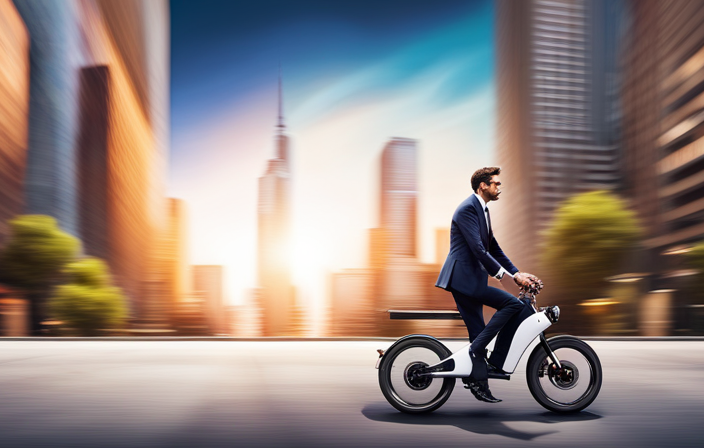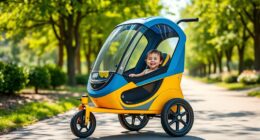So, you’ve decided to hop on the electric bike trend and take a ride into the future. But wait, how do you actually operate this modern marvel? Fear not, my fellow adventurer, for I am here to guide you through the intricate world of electric bike operation.
In this article, I will break down the basic components, teach you how to navigate the controls, and provide you with all the tips and tricks you need to ride your electric bike like a pro.
Get ready to embrace the power of pedal-assisted transportation!
Key Takeaways
- Gear shifting techniques are essential for a smooth and efficient ride.
- Choosing the appropriate gear for different terrains and slopes is important for a comfortable ride.
- Maintaining a comfortable riding position helps prevent fatigue and promotes better control of the bike.
- Being mindful of battery life and range, as well as following traffic rules and safety guidelines, ensures a safe and enjoyable ride.
Understand the Basic Components of an Electric Bike
Let’s dive into the exciting world of electric bikes by first understanding the basic components that make these incredible machines go!
One of the most crucial components of an electric bike is the battery. Understanding electric bike batteries is essential to ensure you choose the right electric bike for your needs. Electric bike batteries come in various types and capacities, which affect the range and power of the bike. It is important to consider factors such as battery size, voltage, and energy density when selecting an electric bike.
Additionally, when choosing the right electric bike for your needs, you should also consider factors such as motor power, frame design, and suspension. Familiarizing yourself with the controls and display is the next step in becoming proficient in operating an electric bike.
Familiarize Yourself with the Controls and Display
Get to know all the controls and display on the e-bike, so you can easily navigate through its features and functions. How can you ensure a smooth ride without being familiar with the controls and display?
Familiarizing yourself with the controls is crucial for a safe and efficient electric bike operation. The controls typically include a handlebar-mounted control unit with buttons or a touchscreen display, allowing you to access various functions such as power assistance levels, lights, and battery status. Understanding the display is equally important as it provides essential information like speed, distance traveled, and remaining battery life.
By familiarizing yourself with these controls and display, you’ll have complete control over your electric bike and be able to make informed decisions during your rides.
Now, let’s move on to the next section on how to turn on the electric bike.
Turn On the Electric Bike
To start your ride, simply flip the power switch and feel the exhilaration of the electric bike surging to life. Once the bike is turned on, you might encounter some common issues that can be easily resolved through troubleshooting.
Here are two sub-lists to help you troubleshoot your electric bike:
-
Battery-related issues:
-
Check if the battery is securely connected and properly charged.
-
Ensure that the battery is not damaged or worn out.
-
Motor-related issues:
-
Make sure the motor is engaged and not stuck.
-
Check for any loose connections or damaged wires.
By following these troubleshooting steps, you can quickly identify and resolve any issues that may arise with your electric bike.
Once you have resolved any problems, you can move on to adjusting the pedal assist level for a customized riding experience.
Adjust the Pedal Assist Level
Adjusting the pedal assist level on your e-bike is crucial for optimizing battery usage and enhancing your riding experience. The pedal assist level determines the amount of power provided by the electric motor when you pedal.
To adjust this level, locate the control panel on your e-bike’s handlebar. Press the up or down buttons to increase or decrease the assistance level, respectively. Higher levels provide more power, making uphill rides easier, while lower levels conserve battery life for longer rides.
Experiment with different levels to find the one that suits your needs. Once you have adjusted the pedal assist level, you can start pedaling and feel the boost of power propelling you forward.
It’s time to hit the road and enjoy the thrill of electric biking!
Start Pedaling
Once you’ve set your desired pedal assist level, simply start pedaling and feel the exhilarating boost of power!
Before you begin, make sure you have adjusted the seat height to a comfortable position. This is important for maintaining balance and ensuring a smooth ride.
To adjust the seat height, loosen the quick-release lever or use the designated adjustment mechanism and raise or lower the seat until your legs are almost fully extended when the pedal is at its lowest point.
Once you are ready to start pedaling, push down on the pedal with your foot to initiate the electric motor’s assistance. As you pedal, the motor will provide a seamless and powerful boost, propelling you forward with ease.
Now, let’s move on to the next section about how to use the throttle (if applicable) to further enhance your riding experience.
Use the Throttle (if applicable)
Get ready to take your riding experience to the next level by using the throttle (if it’s available) and feel the surge of power at your fingertips. Using the throttle effectively is essential for maximizing the performance of your electric bike.
To get started, ensure that the throttle is in a comfortable position for your hand and within easy reach. When using the throttle, it’s important to maintain proper throttle control to avoid sudden jerks or loss of balance. Gradually increase the throttle to accelerate smoothly and steadily. Remember to adjust the throttle according to the terrain and your riding conditions. As you become more familiar with your electric bike, you’ll develop a sense of how much throttle to apply in different situations.
Now, let’s transition into the subsequent section about how to brake safely and smoothly to complete your riding experience.
Brake Safely and Smoothly
Mastering the art of smoothly and safely bringing your ride to a halt is akin to gracefully taming a wild stallion with expert finesse. When it comes to braking on an electric bike, understanding the proper techniques is essential for both your safety and the longevity of your bike. There are two main types of brakes commonly found on electric bikes: mechanical brakes and hydraulic brakes.
Mechanical brakes, also known as rim brakes, work by the brake pads squeezing against the rim of the wheel. They are less expensive and easier to maintain, but they require more effort to apply and may wear down the rim over time. On the other hand, hydraulic brakes use fluid to amplify the braking force, providing more stopping power with less effort. They are more expensive and require occasional bleeding, but they offer superior performance and modulation.
No matter the type of brake on your electric bike, it’s crucial to practice smooth and controlled braking. Sudden and harsh braking can cause instability and potentially lead to accidents. To brake safely, start by applying gentle pressure to the brake lever and gradually increase the force as needed. This allows for a smooth deceleration and better control of the bike.
In emergency stopping situations, where a quick and powerful stop is required, it’s important to know how to perform an emergency stop. This technique involves applying maximum force to the brakes while shifting your body weight towards the back of the bike. This helps to prevent the bike from flipping over and allows for a more controlled stop.
Transitioning smoothly from braking to shifting gears (if applicable), requires coordinating your actions. Once you have come to a complete stop, release the brakes and shift gears as necessary to continue your ride.
By mastering the art of braking, you’ll ensure a safe and enjoyable riding experience. Now, let’s delve into the next section about shifting gears (if applicable).
Shift Gears (if applicable)
To make your ride smoother and more efficient, let’s explore how you can shift gears on your electric bike.
Understanding gear ratios is essential in mastering gear shifting techniques. Electric bikes typically come with a variety of gears, usually controlled by a shifter on the handlebars.
When shifting gears, it’s important to anticipate the terrain ahead. If you’re approaching a steep hill, shift to a lower gear to make pedaling easier. On the other hand, if you’re riding on flat ground or going downhill, shifting to a higher gear will allow you to maintain a faster speed with less effort.
By mastering gear shifting techniques and understanding gear ratios, you can optimize your electric bike’s performance.
Now, let’s move on to how to navigate different terrains and slopes smoothly.
Navigate Different Terrain and Slopes
As you navigate through different terrains and slopes, imagine effortlessly gliding along the path, smoothly adapting to the changing landscape with ease. When it comes to navigating hills and slopes on your electric bike, it is crucial to choose the appropriate gear to maintain a comfortable and efficient ride. By selecting the right gear, you can ensure that you have enough power to conquer uphill sections without straining the motor or your own pedaling efforts. To help you understand the gear selection process, refer to the table below:
| Terrain Type | Gear Selection |
|---|---|
| Uphill | Low gear |
| Flat | Medium gear |
| Downhill | High gear |
By following this gear selection guide, you can optimize your ride and navigate various terrains with ease. Now, let’s move on to the next section, where we will discuss how to maintain a comfortable riding position.
Maintain a Comfortable Riding Position
Imagine yourself effortlessly gliding along the path, feeling comfortable and relaxed in your riding position. Maintaining a proper riding posture is crucial for a comfortable and enjoyable electric bike experience.
Here are four essential tips to help you achieve and maintain a comfortable riding position:
-
Adjust your seat height: Ensure that your feet can touch the ground while sitting on the saddle. Having the correct seat height will prevent strain on your knees and provide optimal power transfer.
-
Handlebar adjustment: Position the handlebars at a height that allows your arms to be slightly bent when gripping them. This promotes better control and reduces strain on your wrists and shoulders.
-
Relax your shoulders: Keep your shoulders relaxed and avoid hunching forward. This will prevent tension and discomfort in your upper body during long rides.
-
Proper hand placement: Place your hands on the handlebars with a light grip, keeping your fingers relaxed. This allows for better maneuverability and reduces fatigue in your hands and arms.
Maintaining a comfortable riding position is essential for a smooth and enjoyable electric bike journey. By following these tips, you can ensure a pleasant ride while minimizing any potential discomfort or strain.
As you focus on your riding posture and handlebar adjustment, it’s also important to be mindful of your battery life and range.
Be Mindful of Battery Life and Range
Don’t forget to keep an eye on how much juice is left in your battery and how far you can go, so you can avoid the disappointment of running out of power mid-ride. As an electric bike enthusiast, it is crucial to understand battery charging tips and maximizing battery life to ensure a smooth and uninterrupted riding experience. To help you visualize this, let me present a 2 column and 4 row table:
| Battery Charging Tips | Maximizing Battery Life |
|---|---|
| – Use the charger provided by the manufacturer | – Maintain a steady speed |
| – Avoid overcharging the battery | – Limit the use of power-consuming features |
| – Charge the battery before it completely drains | – Keep the battery cool and dry |
| – Store the battery in a cool and dry place when not in use | – Regularly clean and inspect the battery |
By following these guidelines, you can extend the lifespan of your battery and make the most out of each charge. Now, let’s transition into the next section about following traffic rules and safety guidelines to ensure a safe and enjoyable ride.
Follow Traffic Rules and Safety Guidelines
Ensure a smooth and enjoyable ride by adhering to traffic rules and safety guidelines. Pedal through the streets like a well-oiled machine by following these tips:
- When operating an electric bike, it’s crucial to follow traffic rules for your safety and that of others.
- Observe speed limits and always yield to pedestrians and vehicles when necessary.
- Signal your intentions using hand signals and obey traffic signals, just like you would on a regular bicycle.
- Wearing a helmet is essential for your protection.
- It’s also recommended to wear bright and reflective clothing to enhance your visibility to other road users.
By following these traffic rules and safety guidelines, you can confidently navigate the roads and have a safe and enjoyable ride.
Moving on to the next section, let’s discuss how to park and secure your electric bike.
Park and Secure Your Electric Bike
When it comes to parking and securing your e-bike, finding a sturdy bike rack or designated parking spot is crucial for protecting your investment and preventing theft. Here are some parking techniques and tips to keep your electric bike safe:
-
Use a sturdy bike rack: Look for bike racks that are securely anchored to the ground or a sturdy structure, such as a wall. Avoid using flimsy racks that can be easily tampered with.
-
Lock your bike properly: Invest in a high-quality U-lock or chain lock to secure your e-bike. Make sure to lock both the frame and the wheels to the rack or a fixed object.
-
Choose well-lit areas: Park your electric bike in well-lit areas with high foot traffic. This reduces the risk of theft as potential thieves are less likely to target a bike that is visible.
-
Consider a GPS tracker: Install a GPS tracker on your e-bike to increase the chances of recovering it in case of theft.
By following these parking techniques and preventing theft, you can ensure the safety of your electric bike.
In the next section, we will discuss how to perform basic maintenance and care for your e-bike.
Perform Basic Maintenance and Care
After ensuring that your electric bike is securely parked, it’s important to perform basic maintenance and care to keep it running smoothly.
Basic maintenance includes regular cleaning of the bike to remove dirt and debris that can accumulate and potentially damage the components. Additionally, you should check the tire pressure, brakes, and chain regularly to ensure they are functioning properly.
Lubricating the chain and other moving parts is also crucial to prevent excessive wear and ensure a smooth ride. Taking these simple steps will not only extend the lifespan of your electric bike but also enhance your overall riding experience.
Now that we have covered basic maintenance and care, let’s explore the advanced features and settings of your electric bike (if applicable).
Explore Advanced Features and Settings (if applicable)
To fully unleash the potential of your ride, dive into the exciting realm of advanced features and settings on your high-tech two-wheeler. Here are four ways you can explore and optimize your electric bike’s advanced features and settings:
-
Advanced Troubleshooting: Familiarize yourself with the bike’s diagnostic system to identify and resolve any potential issues. This includes understanding error codes, checking sensor calibration, and performing system resets.
-
Battery Performance Optimization: Maximize your electric bike’s battery life by utilizing advanced settings like power mode selection, regenerative braking, and battery management systems. Adjusting these settings can help you achieve longer rides and increase overall battery efficiency.
-
Firmware Updates: Stay up to date with the latest firmware releases from the manufacturer. These updates often include performance improvements, bug fixes, and new features that can enhance your riding experience.
-
Customization Options: Some electric bikes offer customizable settings such as pedal assist levels, throttle sensitivity, and display preferences. Explore these options to tailor your ride to your specific needs and preferences.
By delving into your electric bike’s advanced features and settings, you can take your riding experience to the next level while optimizing battery performance.
Frequently Asked Questions
How do I adjust the seat height on an electric bike?
To adjust the seat height on an electric bike, locate the quick release lever or bolt under the seat. Loosen it, lift or lower the seat to your desired height, and then tighten the lever or bolt securely. Make sure the seat is at a comfortable height that allows for proper leg extension while pedaling.
What are the different pedal assist levels and how do I change them?
To change pedal assist levels on an electric bike, locate the control panel and use the up or down buttons to adjust the settings. Each level offers different amounts of assistance, allowing riders to conserve battery power or receive maximum support when needed.
Can I ride an electric bike in the rain?
Yes, you can ride an electric bike in the rain. However, it is not recommended to ride in snowy conditions as it can be dangerous. Riding in hot weather may slightly affect the battery performance.
How often should I recharge the battery on an electric bike?
I should recharge the battery on my electric bike regularly to ensure optimal performance. The recharge frequency depends on my usage, but generally, it’s recommended to recharge after every ride. This helps prolong the battery lifespan and ensures a reliable riding experience.
Are there any specific safety precautions I should take when riding an electric bike at night?
At night, it’s crucial to prioritize safety on an electric bike. Enhance nighttime visibility by using proper lighting such as bright headlights and rear lights. Ensure you are easily seen by other road users to prevent accidents.
Conclusion
In conclusion, operating an electric bike is as easy as riding a regular bike, but with an added boost of power. Just like a fish gliding through water, an electric bike effortlessly glides through the streets, providing a smooth and efficient ride.
By understanding the basic components, familiarizing yourself with the controls, and following traffic rules, you can safely enjoy the benefits of an electric bike. Remember to perform regular maintenance and explore advanced settings for an enhanced riding experience.
So hop on your electric bike and experience the freedom and exhilaration it offers!






